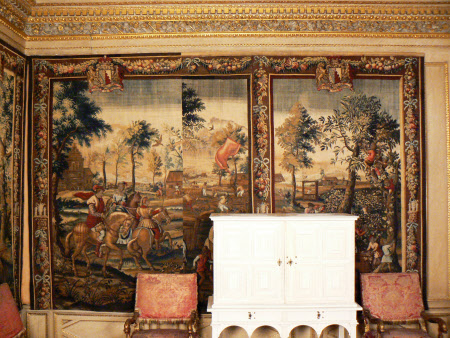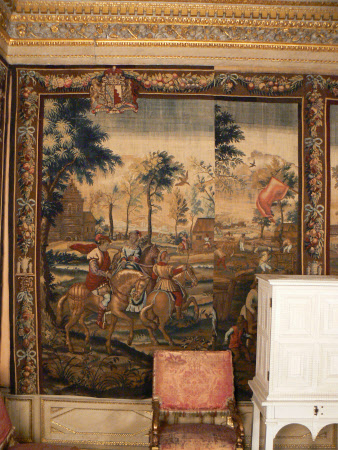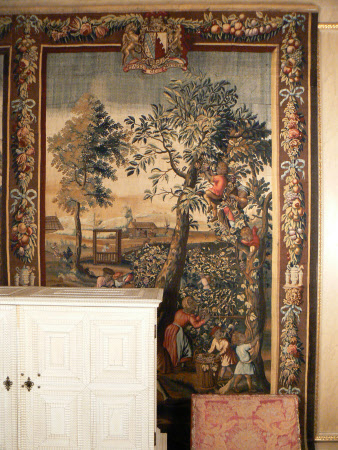May, August and October
Stephen de May (fl.1690 - 1710)
Category
Tapestries
Date
circa 1699 - circa 1714
Materials
Tapestry, wool and silk, 8 warps per cm
Measurements
2782 x 4308 x 8 mm
Place of origin
Lambeth
Order this imageCollection
Ham House, Surrey
NT 1140555.3
Summary
Tapestry, wool and silk, 8 warps per cm, May, August and October from a set of four Months, Stephen de May, Lambeth, c. 1699-1714. Parts of three rustic scenes divided by a central border and a vertical join. On the left the month of May is represented by a hawking scene, with gentlemen and a lady on horseback, the man in the foreground carrying a hawk on his wrist. The scene ends abruptly on the right and is sewn onto a strip from a scene representing the month of August, with amorous peasants in the foreground and a harvest scene in the background, and a red flag on a flag pole near the top. To the right of the central border is a scene of a grape harvest, representing the month of October. On the right boys climb a tree to collect the grapes which are carried in barrels to a large vat on the left where a man tramples them, the juice flowing out into a basin. Above 'May' and 'October' are coats of arms with the motto 'UT APES GEOMETRIAM'. The borders are composed of fruit and flowers tied by blue ribbons on a brown ground, with lion masks in the side borders. There are vertical joins either side of the strip of 'August'. The tapestry has no lower border and has been folded in at the bottom by around 4 inches.
Full description
The four tapestries of the 'Months' at Ham House are part of a larger series representing the twelve months of the year according to the typical countryside activities of each. Representations of the labours of the months have their origin in early Christian calendars where they were associated with the signs of the zodiac and signified the passing of celestial and terrestrial time until the Second Coming and the Last Judgement (Webster, 1938). The iconography of the months, focussing on the agricultural activities associated with them, was developed in the illustrations to medieval books of hours. During the fourteenth century these scenes were often expanded into representations of daily life, the best-known example the 'Très-Riches Heures' begun in 1411-13 by the Limbourg brothers for Jean, Duc de Berry. Although the iconography was never fixed certain activities came to be associated with each month, for example haymaking in June, harvesting in August and wine making in October, all see in the Ham House series. The subject of the labours of the months was very popular in tapestry design from the early sixteenth century. A number of important series were designed between c. 1520 and 1540, including the so-called 'Medallion Months', the 'Months of Lucas', that were in the French Royal Collection and were repeatedly copied during the seventeenth and eighteenth centuries, and the famous 'Hunts of Maximilian', which were also copied at the Gobelins and elsewhere (there is a Flemish seventeenth-century variant in the National Trust's collection at Upton House, no. 446875). The Ham tapestry designs are based on a now lost early sixteenth-century tapestry series that was copied at Mortlake in the early seventeenth century, possibly from a set in the collection of Henry VIII, and woven for Charles I in the early 1620s, with new borders designed by Francis Cleyn. A complete set of six (each tapestry including two months) made at Mortlake for Dr. John Williams, Bishop of London in the early 1620s is in the collection of the City of Genoa (Hefford 2006) and a partial set with the arms of Charles as Prince of Wales is in the Royal Collection with three panels on display at Kensington Palace. The designs, sometimes referred to as the 'Seasons' as well as the 'Months', became one of the staples of the Mortlake workshop, and continued to be woven after the Restoration of 1660. A set of 'Months' in the National Trust's collection at Clandon Park was probably woven at Mortlake in the 1660s or 1670s (no. 1441619). In the 1670s a set woven with gold thread was made for the Queen's Bedchamber at Ham House by the Royal Arrasworker, Francis Poyntz, who also supplied sets of 'Months' with gold thread to Charles II (see Wyld forthcoming a). The activities of the months in the original Mortlake series of 'Months' (and the now-lost sixteenth-century series it was based on) are as follows: January – a meal by the fire-side February – grafting fruit trees March – pruning vines and digging a vegetable garden April – milking May – nobles hunting with a falcon June – sheep-shearing July – haymaking August – the harvest September – sowing seeds October – treading and casking wine November – threshing December – pig-killing Although the tapestries at Ham are based on those woven at Mortlake, various alterations have been made to the designs which differ in many details from the early Mortlake weavings, including the addition of children climbing a vine in 'October', and an entirely new scene for 'August'. The scenes that survive at Ham are as follows: April – milking May – nobles hunting with a falcon June – sheep shearing July – haymaking (June and July combined in one scene) August – peasants drinking at an inn September – sowing seeds October – gathering grapes, treading and casking wine The added boys climbing a tree covered with vines in 'October' derive from another set of Mortlake tapestries, the 'Playing Boys', partly based on sixteenth-century designs by Giulio Romano. There are Mortlake 'Playing Boys' tapestries at Belvoir Castle and Holyrood House (Swain 1988, pp. 8-11). The scene of peasants at an inn that has been used for the month of August is Flemish in origin. The same scene appears in a 'Teniers' tapestry in the National Trust's collection at Polesden Lacey (no. 1247022.1). The tapestries at Ham were probably woven not at Mortlake but in the workshop of Stephen de May (d. 1714). De May was descended from one of the Flemish weavers who came to London after the foundation of Mortlake in 1619. He may well have been trained at Mortlake, but at some point before 1690 after he set up his own workshop in Spring Gardens in the parish of St Mary, Lambeth (Hefford 2002, p. 55-8). De May offered versions of a number of old Mortlake designs. According to George Vertue he was in the possession of the workshop's cartoons for the 'Acts of the Apostles', copied from Rahael's originals by Francis Cleyn (Vertue 1930, pp. 59, 68), and it is possible that he acquired other Mortlake cartoons as well, perhaps after the workshop closed in 1703. One commission to de May is recorded in detail: in 1699 he was commissioned by Daniel Finch, Second Earl of Nottingham to make tapestries of the 'Acts of the Apostles', 'Hero and Leander' and the 'Months', all Mortlake subjects. The 'Months' were "to be made after the pattern of those in the Queen's Drawing room at Windsor, as fine as those except gold and silver instead of which muse be silk." (Finch 1907; Finch 1901, vol. 1, pp. 88-97). A large panel with the months of March, April and May (subsequently split into three separate panels), and the signature 'SDM', gives us some idea of the appearance of de May's weavings of the 'Months' (Hefford 2006, pp. 172-4). The rendering of the figures is similar, though not identical, to versions of the same scenes at Ham, and the borders with their bunches of fruit tied with blue ribbons on a dark brown ground and lion masks at each side are also very similar to the Ham borders. The 'Months' tapestries at Ham are woven with the arms of Petty impaling Boyle, for Henry Petty, 1st Earl Shelburne (1675-1751), who married Arabella, daughter of Charles Boyle, 3rd Viscount Dunvegan in 1699. This allows the tapestries to be dated to after 1699, and as the arms have a Baron's coronet they can be dated to before 1719 when Shelburne was created Viscount Dunkerron and Earl Shelburne. It is not known how the tapestries came to Ham as there are no obvious connections between the Petty and Tollemache families. They are first recorded in the 1844 inventory of the house, hanging in Lady Dysart's Bedroom on the second floor. The tapestries have been considerably altered to fit into their present location in the North Drawing Room, with panels of April and September sewn together with part of an upper border inscribed for June July and August; panels of May, part of August and October sewn together; a new right-hand border attached to a panel of June and July, and a further fragment from August discarded and now kept in store. (Helen Wyld, 2011)
Provenance
Made for Henry Petty, 1st Earl Shelburne, between 1699 and 1714; at Ham House by 1844; acquired in 1948 by HM Government when Sir Lyonel, 4th Bt (1854 – 1952) and Sir Cecil Tollemache, 5th Bt (1886 – 1969) presented Ham House to the National Trust, and entrusted to the care of the Victoria & Albert Museum; returned to the care of the National Trust in 1990, ownership transferred to the National Trust in 2002.
Credit line
Ham House, the Dysart Collection (purchased by H.M. Government in 1948 and transferred to the National Trust in 2002)
Marks and inscriptions
Motto below coats of arms in upper border: UT APES GEOMETRIAM
Makers and roles
Stephen de May (fl.1690 - 1710), workshop
References
Wyld, 2013 a: Helen Wyld, 'Seventeenth-century Tapestries at Ham House', in Christopher Rowell (ed.), Ham House: 400 Years of Collecting and Patronage, New Haven and London 2013, pp. 178-93 Hefford, 2006: Wendy Hefford, 'I Mesi di Mortlake, un serie di arazzi inglesi a Genova', in P Boccardo and C Di Fabio (eds.), Genova e l'Europa atlantica: opere, artisti, committenti, collezionisti, Milan 2006, pp. 167-181 Hefford, 2002: Wendy Hefford, ‘Flemish Tapestry Weavers in England: 1550-1775’, in Guy Delmarcel (ed.), Flemish Tapestry Weavers Abroad, Leuven 2002, pp. 43-61 Forti-Grazzini, 2003: Nello Forti-Grazzini, Gli Arazzi della Fondazione Giorgio Cini, Venice 2003 Swain, 1988: Margaret Swain, Tapestries and Textiles at the Palace of Holyroodhouse in the Royal Collection, London 1988 Webster, 1938: J. C. Webster, The Labours of the Months in Antique and Medieval Art to the End of the Twelfth Century, Princeton 1938 Vertue 1930 George Vertue, 1930: Notebooks’, vol.I, The Walpole Society, Oxford, Vol.XVIII (1929–30) Finch, 1907: Pearl Finch, 'The Tapestry at Burley-on-the-Hill', The Connoisseur, vol. XIX (September-December 1907), pp. 42-47 Finch, 1901: Pearl Finch, A History of Burley-on-the-Hill, 2 vols, London 1901


